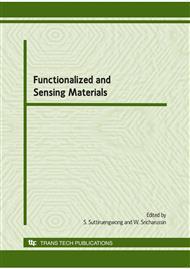p.401
p.405
p.409
p.413
p.417
p.421
p.425
p.429
p.433
Spray-Dried Pectic Polysaccharide Powders: Evaluation of Physicochemical Properties for Pharmaceutical Preparations
Abstract:
Pectic polysaccharide from durian rinds (Durio Zibethinus) has been reported to mainly compose of pectin which is generally used in various pharmaceutical dosage forms. The purpose of this research was to investigate the physicochemical properties of spray-dried pectic polysaccharide powders as a function of spray drying conditions (inlet temperature, feed rate, and aspirator rate) and formulation parameters (pectic polysaccharide concentration). A mini spray dryer was used to spray dry pectic polysaccharide in formulation with maltodextrin, colloidal silica and propylene glycol. Production yields were obtained between 31.08 – 52.87%. Higher yield percentage was obtained when the inlet temperature was increased. Particle size of < 7m was from low pectic polysaccharide concentration. The pectic polysaccharide powders were bulky and the shape was almost spherical with smooth surface but collapsed at high inlet temperature and low feed rate. At 75% RH and room temperature, the powders could adsorb moisture of about 12% of the powder weight. The swelling index and mucoadhesion time that the powders attached to the porcine intestine was ranged 14 – 70 and 7 - >30 minutes, respectively. This research provides useful information for development of pectic polysaccharide as fine powder for drug delivery.
Info:
Periodical:
Pages:
417-420
Citation:
Online since:
January 2010
Price:
Сopyright:
© 2010 Trans Tech Publications Ltd. All Rights Reserved
Share:
Citation:


